A month of extremes
Friday, June 1, 2012
Following on from a difficult April, another very challenging
month in the garden with extremes of temperatures from below zero
to sub-tropical, frequent heavy rain until mid month and cold
northerly winds. Extremes too in the vegetable garden with
brassicas and lettuces doing well under the fleece, but all small
seeds (carrots beetroot and parsnips failing and having to be
re-sown recently) and potatoes set back by the late frosts.
A good stand of brassicas grown under fleece. Invaluable
for earlier crops.
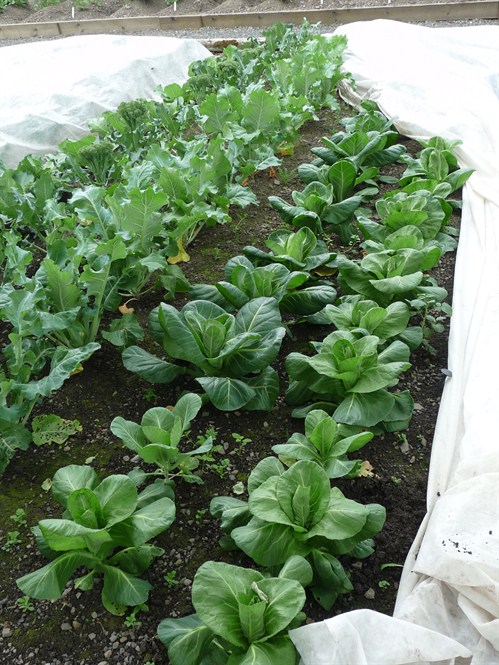
Things have picked up well in the last week thanks to the
sunshine and warmth as welcome for us as the plants. This has
prompted me to set up Moira's free standing swimming pool, a sure
sign that the weather will take a turn for the worse! The
conservatory is habitable and all the major works are completed. We
are really enjoying it and with floor to ceiling glass it is nice
to be "inside but out" with lovely views all round.
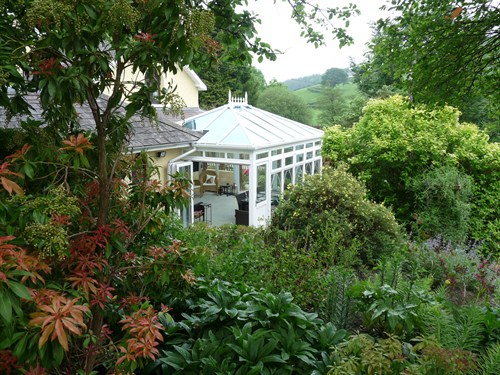
Weather report.
A min of -1C on three nights mid month, 2 days of 29C in the
last week, and some very mild nights too. Rain was frequent early
on and generally of the torrential kind which raised our river to
its highest levels of the year.
Garden update
With the conservatory works taking a lot of time it has been
difficult to keep on top of all the myriad of tasks demanded of the
gardener in May, without coubt the busiest month of the year. A lot
of time consuming jobs like putting out fleece on colder
nights and watering the nursery and recent plantings twice a day
has eaten into time for work in the nursery, mowing lawns,
and weeding borders - the continual battle with weeds has
accelerated with the arrival of warmer weather. If it isn't done
the annual weeds will shed their seeds and another generation will
be waiting to spring up within a few weeks.
It's not all gloom and doom because there is that glorious
freshness that comes with the May garden and all the promise of all
the good things to come as the herbaceous plants fill out and a few
start to come into flower. A first cut of broccoli (only sown in
mid April!) and lettuce (mixed salad leaves and Little Gem lettuce)
was very welcome and is always a special event in the garden
calendar.
Mice have decimated all sowings of peas and there is occasional
damage to a wide variety of plants from rabbits. Can mice read? I
swear that within less than a week of sowing, just as the peas
soften and start to sprout, the mice instinctively know this and
move in for the feast. How else do they know this other than by
reading the labels?
Moira managed to dead head all the hellebores before the seed
was shed so less seedlings to trouble us next year. However if you
have some choice forms it is relativley easy to gather the seed
just before it is shed, sow in pots in some good compost, cover
with grit and keep somewhere cool and shaded, and you could have
some good germination and little plants to pot on next spring but
they may not come true to their parents. Please note mice can also
read hellebore pot labels!
Germination of seeds in the propagating tunnel has been very
good and there is still plenty of pricking out and potting on to
do. It has however quitened down since the peak activity in
April.
What's looking good?
So much at this time of year its impossible to name them all but
the colours of the month must surely be yellows and blues!
Lupins, delphiniums, hardy geraniums, violas, clematis,
hostas (leaves) and aquilegias to name just a few that contribute
so much to these colour spectrums.
A marvellous seed grown species, clematis patens sown in
2005
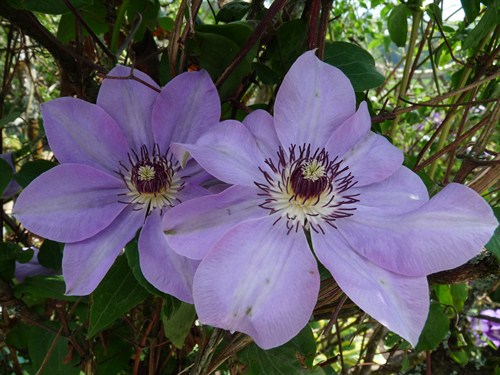
Yellow tree lupin (lupinus arborecens)
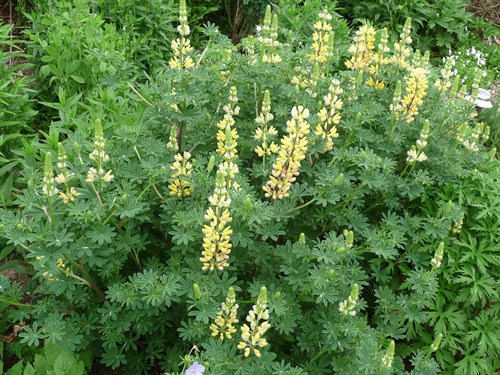
Such an exciting time of year with something new coming
into flower every day.
Aquilegias have been magnificiient in a wide range of
colours and forms. Some from my own seed have shown striking
variations from the parent plants, and in one or two cases very
desirable size or colours. Hybrids showing such variation
being very common in the rununculacea family (buttercups) to which
aquilegias belong. One goup flowering for the first time with me
has been the McKenna Giant hybrids, tall with large flowers and
long spurs in a great range of colours including numerous
bicolours. A hybrid group far removed from the "Grannys Bonnets"
frequently considered by many gardeners to be the "type" plant in
the aquilegia genus.
A collection of fine aquilegias in the
nursery
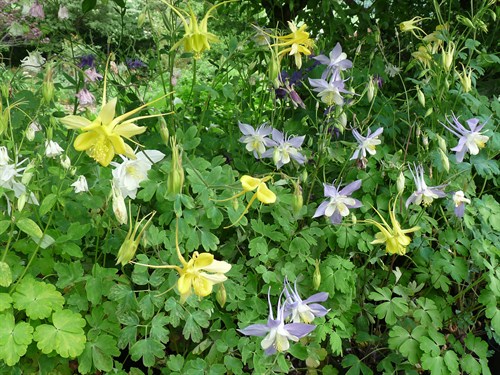
Bearded iris although much later than some previous years have
been stunning and enjoyed the sunshine and lack of rain and wind.
Being the tall forms of bearded iris they usually flop and need
staking but not this year. They have a most delicate yet alluring
perfume unlike any other flower scent I know which is heightened in
warm sunshine
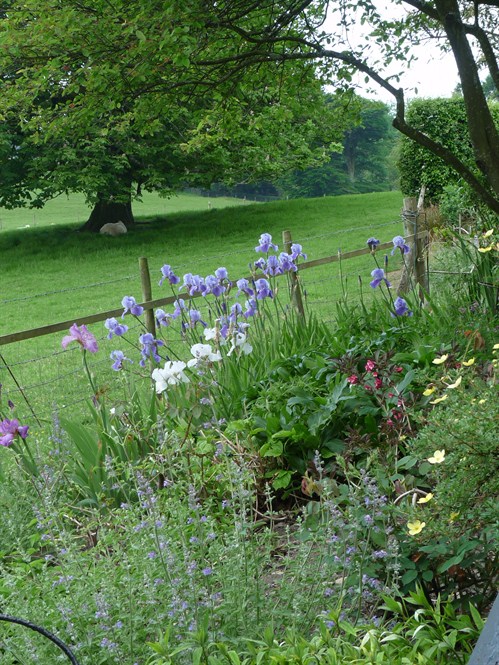
Various forms of moisture loving primulas are putting on a
tremedous show, particularly the candelabra types. Waterlilies too
are starting to grow away since the warm weather came as is the
blanketweed which will need urgent attention soon.
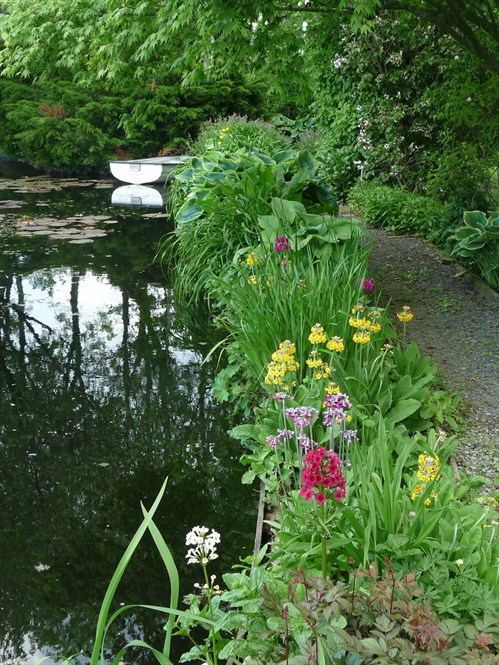
Oriental poppies are just coming into bloom with my all time
favourite "Beauty of Livermere", a stunning true red, the star
performer.
Just in case you are bored of blue and yellow flowers,
what about this for "in your face" red?
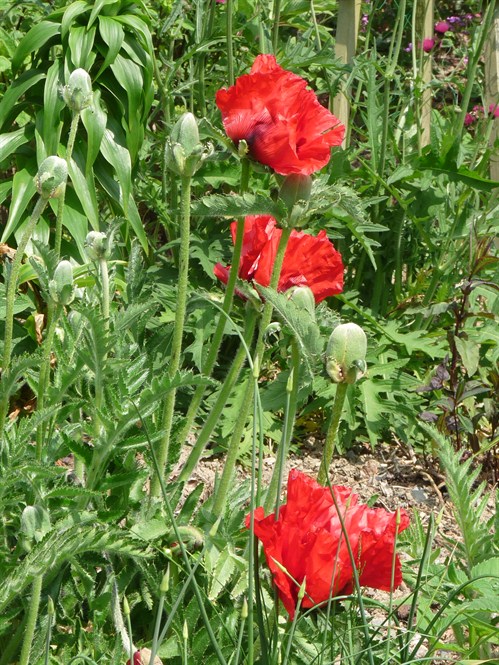
Many viburnums and cornus are flowering now, a particularly
attractive cultivar being V. sargentiana "Onadanga" with lacecaps
rather like a small Hydragea serrata
It's good to see some overwintered dahlias coming thorugh
especially in the Red Border, and my old friend of 12 years,
impatiens tinctoria of which I have waxed lyrically about in News
items in previous years, has come through another winter.
Hostas have recovered from the ravages of April and look well
now, particularly the dwarf and small varieties which I planted
only last year in a small half shaded rock garden near to the
house, a good way to display the smaller forms of which there is an
increasing range but expensive number.
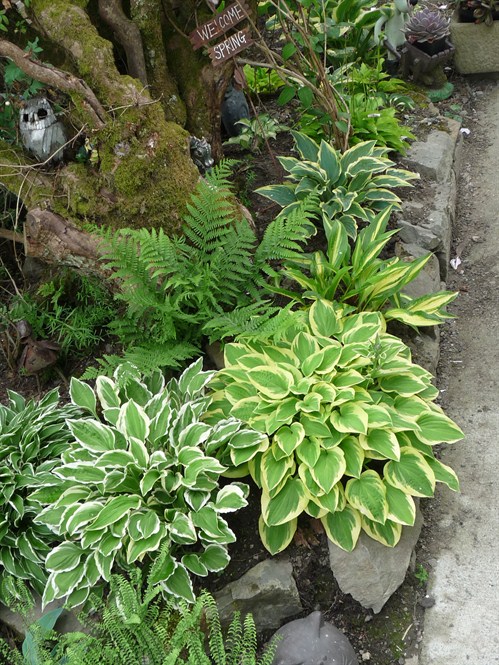
These are just some of the many good looking things and there
are plenty more to come in June.
Wildlife and countryside
Just as with the plant kingdom there is so much happening now in
the animal kingdom. A pair of pied wagtails successfully raised a
brood of six chicks which flew last week (only 12 days to fledge
before they were capable of flying - incredible!) 2 almost
immediately were picked off by the ever rapacious magpies, but the
others have survived and we have seen them regularly in the
gardens. They are lovely unassuming birds which appear to run more
than they walk and eat prodigous quantities of insects.
Regular sightings of redstarts in the hedgerows, red kites in
profusion but no sightings of the pied flycatchers after the
territorial battle with the blue tits over the nest box in the old
alder.
The warmer weather has brought out a variety of damselflies
which always show before their larger dragonfly cousins. As yet
though no blue demoiselles, my favourite damselflies. Some mayflies
on the wing during the warmest weather and quite a rare sight here.
Tadpoles of the frog variety have grown large and there are some
already at the four leg stage leaving the water briefly on wetter
days.
Staying close by the water I observed a very funny sight last
week. Two mallards were rooting quietly about in the field across
the river when a Dorset ewe took umbrage with them and started to
chase them. If you have ever seen a mallard tring to run it is
funny enough but chased by a sheep it reaches new heights of
comedy. It was a stop/start affair that lasted a good few
minutes before the ducks had enough and flew off. I was in stitches
by that time!
Wild flowers everywhere with a wide variety including the
ubiquitous "moon" daisies, ladies smock (cardamine pratensis)
flowering for a long time in he cooler weather daisies, ragged
robin, some orchids including early spotted and southern marsh
orchids (dactylorhizza praetermissa), yellow vetch and others too
numerous to list.
Our friends Anne and Philip have a field full of
the most incredible range of wildflowers in 3 habitats:- woodland,
open upland grassland and marshy ground where Ladies smock, meadow
buttercups and wild forget-me-nots sit in perfect harmony. Nature
always does it best.
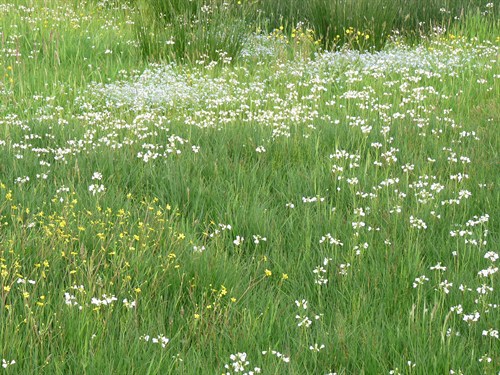
Visits and visitors
It seems strange this year to have no visits booked for early
June but it has taken the pressure off whilst we do all the tidying
up work following completion of the conservatory. We are behind
with some of our plantings as a consequence so the break will give
us time to complete this before our first visitors arrive later
this summer.
Our talk at the Spring Festival at The Royal Welsh Showground
went well but there was a very sparse attendance which reflected
the general lack of footfall in the horticultural areas of the show
although other areas seemed very well supported. Hope the Main RWS
in July goes better from the horticultural perspective and
especially my talk on Growing Vegetables.
Rmemember if you would like to visit the gardens during mid
August - end of September please get in touch. The garden nursery
is however open most of the time but just please give us a call to
let us know when you would like to come to make sure we will be at
home.